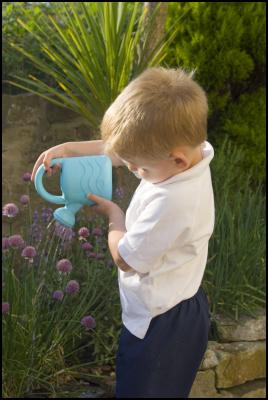Eco-friendly gardening is the way of the future

Portulaca Growing in
Rocks
It’s strange to think that just by getting out in the garden we could be damaging the environment, but it’s true, says Awapuni gardening guru, Tod Palenski.
“Just think about all that watering, all those fertilisers, all that lawn mowing. These things do have an environmental impact but we can reduce the damswge while still retaining a beautiful garden.

Recycling rain water for garden
“To start with, this means finding plants that suit our new conditions, ones which don’t require a lot of maintenance so that your garden continues to flourish without wasting too many precious resources.”
Tod says if you want to do your part, start looking for plants which don’t require a lot of watering.
“Alyssum, portulaca and petunias are good examples of plants which have adapted to sunny, dry conditions, which means they don’t require a lot of attention. They’re what I call plant-and-forget flowers, which makes them great for planting at the batch or in your home garden if you’re not going to be around to water them.”
Portulaca is particularly at home at batch and beach environments. With succulent stems and leaves and small, bright rose-like flowers, portulaca thrives in dry or rocky areas, sand and gravel.
“It’s perfect to use as an edging at the front of borders, in spaces between stepping stones and even in cracks in rock walls,” says Tod. “Awapuni’s traditional value portulaca, available at most supermarkets and garden centres, will flower right through to autumn.”
As well as choosing low-maintenance flowers, today’s gardeners are also having to rethink their lawns. Traditional high-maintenance, perfectly manicured lawns require a considerable amount of water, chemicals and machinery in order to keep them emerald green and weed free.
“As water saving techniques grow in importance, we’re starting to be less fastidious about our grass,” says Tod. “In time we may see a move towards wilder, more meadow-like ground coverings.”
However, if you want to keep your lawn looking green over the summer without too much watering, Tod suggest taking the catcher off your mower.
“Grass clippings make good mulch for the lawn and act as a good fertiliser too. You’ll also find that the longer you have them the less watering they’ll need, so don’t cut them too short.”
Mulching is a great way to keep the moisture in your plants as well. Tod suggests using pea straw with roses, vegetables and fruit trees.
“Pea straw will help retain moisture in your soil and avoid overhead watering which can cause fungus such as rust and black spot from forming. A good covering will also help prevent weeds.”
Tod’s top tip for mulching is to
ensure you add fertiliser to the soil and give it a good
drenching before you mulch, then press your mulch down
really well. How much mulch? Tod recommends mulching to
100mm, particularly if you don’t have a weed mat, but no
deeper than 50mm around the base of trees and bushes to
prevent rotting and fungus.
“Once you’ve laid your mulch you’ll find you don’t need to water as often. It’s a good idea to check the soil every few days down to a depth of about 100 mm to see if it needs watering,” he says.
“Giving plants a really deep drink late at night or first thing in the morning is much more beneficial than leaving a sprinkler on for hours.”
Installing rain gutters and collecting water from downspouts also helps reduce water use.
“Some people keep old containers and even baths in their gardens to collect rainwater which they use to keep their plants moist without relying on the tap or hose too much. Get the kids to help recycle the water collected using their own watering cans.”
Water crystals, available at all good gardening stores, are also great for reducing water use, because they can hold up to 400 times their weight in water and many contain water-soluble nutrients and fertilisers.
“Using water crystals in pots and hanging baskets and choosing plants that don’t require a lot of watering will help your garden stay colourful even during the driest months,” says Tod.
“There are lots of creative ways to use less water, which will save you time and help you do your bit for the environment”
ENDS


 New Zealand Symphony Orchestra: Experience Out-Of-This-World Music With The NZSO And Star Violinist
New Zealand Symphony Orchestra: Experience Out-Of-This-World Music With The NZSO And Star Violinist  NZ Institute of Safety Management: Open Letter To Minister On Labour Day Urges Investment In WorkSafe, Not Radical Change
NZ Institute of Safety Management: Open Letter To Minister On Labour Day Urges Investment In WorkSafe, Not Radical Change Aged Care Association: ACA Urges Government Action As Future Of West Coast Palliative Care In Question
Aged Care Association: ACA Urges Government Action As Future Of West Coast Palliative Care In Question Save The Children: Welcomes Announcement Of Remodelled Ka Ora, Ka Ako Healthy School Lunches Programme
Save The Children: Welcomes Announcement Of Remodelled Ka Ora, Ka Ako Healthy School Lunches Programme Te Ara Ahunga Ora Retirement Commission: New Financial Education Partnership Helps Rangatahi Learn About Money
Te Ara Ahunga Ora Retirement Commission: New Financial Education Partnership Helps Rangatahi Learn About Money NZ Comedy Trust: New Zealand Comedy Trust And RNZ Launch Comedy Podcast Development Fund
NZ Comedy Trust: New Zealand Comedy Trust And RNZ Launch Comedy Podcast Development Fund 